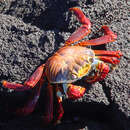en
names in breadcrumbs


Among other ecoregions, this taxon occurs in St. Peter and St. PaulRocks, a set of small rocky islands far out in the Atlantic Ocean between Brazil and the coast of West Africa. In particular, there are five islets, five very large rocks and a series of smaller skerries that comprise this formation.The rock type of this formation is ultramafic and not volcanic.
This is one of the few places on Earth where an underwater oceanic ridge breaks through the surface of the sea. This formation, also known as St. Peter and St. Paul Archipelago, is the second tallest deep sea mountain or megamullion. These isolated rocks function as a biogeographic oasis in the deep ocean, providing a prime niche for marine life to prosper nearer the ocean’s surface. While the islands are virtually devoid of terrestrial vegetation, the rich marine flora and fauna provides a food source to seabirds that reside and breed here.
Isolation from the mainland provides a habitat of significant ecological and biogeographical interest. More than 800 kilometers from South America, St. Peter and St. PaulRocks (0°56’N, 29°21’W) land area is estimated to be only 15,000 square metres. Composed of mylonitic peridotite, the submarine mountain of which these rocks are the pinnacles extends 4000 metres into the ocean depths. St. Peter and St. PaulRocks were visited by Charles Darwin in 1832 on the first Beagle expedition.
The structure of the islets is a rugged serpentine surface, consisting of numerous fissures, pinnacles and ridgelines.The meager terrestrial vegetation that does occur includes simplistic marine grasses, mosses, fungus and algae. A filamentous blue-green algae, Lyngbya spp, and a minute green algae as Stichococcus bacillaris are example flora.The ocean floor structure in the vicinity of the formation is very irregular as well as steep and rocky; silt bottoms do not occur to the north and south until attaining a depth of approximately three km.
While terrestrial flora is scarce, the isolated islands provide habitat for a rich benthic and littoral marine biota. This food source supports many seabirds, which are the only vertebrate wildlife found on the islands. Breeding seabirds found on the Rocks during the 1971 survey included Brown booby (Sula leucogaster), Brown noddy (Anous stolidus), and Black noddy (Anous minutus). All life-cycle stages of the booby were found during this survey, suggesting that their breeding was aseasonal. The bird eggs often fall prey to Sally Lightfoot Crabs (Grapsus grapsus), a marine invertebrate that is present in large numbers on the islets. The invertebrate element of the Rocks’ food chain primarily consists of microbial feeders. These include protozoa, nematodes (Acrobeloides, Diploscapter and Panagrolaimus genera), bdellodes rotifers, and certain mites (Scheloribates spp.).